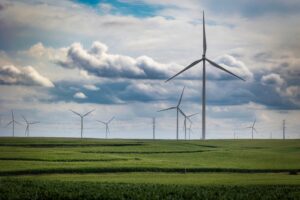
The rise of wind power has been crucial in reducing carbon dioxide emissions and tackling climate change. Minnesota has been a leader in deploying wind turbines, and wind accounted for 21% of the state’s electricity generation in 2021. Minnesota’s cumulative wind power capacity grew from 107 megawatts in 1998 to nearly 4,600 megawatts by 2021’s close, according to the Minnesota Department of Commerce. All that wind power came from 3,959 turbines (each with three blades).— Star Tribune, 10 December 2022
Unfortunately, wind turbines don’t last forever. Their normal useful life is about 20 years. The concrete bases, steel towers, and electrical components are relatively easy to recycle, but recycling wind turbine blades is another matter entirely.
Unlike an aluminum can or glass bottle, the blades are often constructed of fiberglass, steel, wood and resin—components that are tough to sort during processing. Their mammoth size also can present a logistical challenge.—Robert Cappadona
In addition, the low value of the fiberglass and plastic makes it hard to justify the cost of transporting the massive blades from a remote wind farm to a recycling facility. As a result, the blades often just end up in landfills. Can we do better than this?
Making cement from waste materials
We’ve discussed previously how to make cement using waste materials. When done right, this practice saves resources by displacing virgin materials. It also reduces the volume of waste going into landfills. In some cases it can even eliminate toxic materials from the waste stream. The key is to use all of the components of the waste material and proportion the constituents of the raw kiln feed to get the right mixture.
For example, some cement plants use scrap tires as a fuel source. The rubber becomes fuel in the kiln, and the steel belting provides iron for the cement clinker. You’d need to reduce or eliminate whatever you were using as your iron source to maintain the same clinker composition. You might also adjust the amount of gypsum you grind with the clinker to compensate for the sulfur in the rubber.
If the waste material is toxic, you have to figure out how to render the toxins less harmful. For example, waste solvents are toxic because of the shape of the molecules. In that case, burning long enough at a high enough temperature will dissociate the molecules. To do that, you need to inject them into the hottest part of the kiln. You also need to control the process to make sure they burn completely. And you’ll need to ensure that any emissions are properly controlled. The good news is that if you do all that, someone will pay you to burn fuel you’d otherwise have to buy.
Recycling wind turbine blades in cement manufacture
Wind turbine blades are about 70% silica (from the fiberglass); the rest is mainly plastics. Cement clinker comprises lime (calcium oxide), silica, aluminum oxide, and iron oxide. That is, scrap turbine blades can supply silica and fuel to the cement kiln.
Cement manufacture won’t solve the entire problem. To that end, a consortium of European and US companies is working toward additional solutions that amount to more than just wishcycling.
In DecomBlades, the ten project partners will investigate and develop solutions to recycle the composite material in wind turbine blades. The project focuses on three specific processes: shredding of wind turbine blades such that the material can be reused in different products and processes; use of shredded blade material in cement production; and, finally, a method to separate the composite material under high temperatures, also known as pyrolysis.
